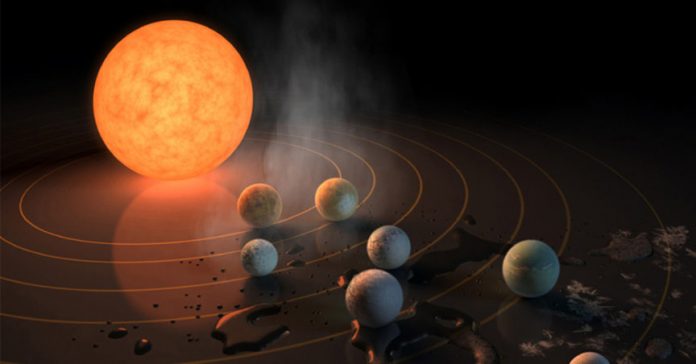Nasa discovers seven new exoplanets with great potential for alien life.
Despite their abundance, however, a NASA announcement about exoplanets today is going to grab news headlines around the world. Scientists have found that a star called Trappist-1, only 39 light years away, is being orbited by seven Earth-sized, rocky planets.
The reason this is a big deal is not because scientists have found so many Earth-like planets at once. We’ve already discovered hundreds of those. Nor is it because Trappist-1 is so close. The star Proxima Centauri is only four light years away, and it too has an Earth-like planet in its orbit. The Trappist-1 solar system is a big deal because it’s going to be the test bed for accelerating our search for alien life.
The most common method to search for planets involves looking at a star continuously and measuring any changes in the amount of light coming from it; a dip in sunlight likely means a planet crossed between the star and our observatory. Because the only life we know developed in our Earth-sun system, astronomers have focused their exoplanet search around sun-like stars, assuming they’d offer the highest likelihood of hosting a life-giving planet. The Trappist-1 discovery is likely to change this strategy.
Trappist-1 is an ultra-cool dwarf that’s barely bigger than Jupiter—a type of star much more common in our galaxy than sun-like stars. Now that we’ve found so many Earth-like planets circling among the first few ultra-cool dwarfs observed closely, including Trappist-1, it means we should probably start focusing efforts on these types of star systems. And since there’s so many of them out there, the Trappist-1 discovery raises the possibility that finding more such solar systems may prove to be nothing out of the ordinary.
And there’s more about Trappist-1 that’s getting astronomers and space lovers excited. When NASA and its European counterpart, ESA, launch the James Webb space telescope in 2018, scientists will have the ability to look at the chemical properties of an exoplanet’s atmosphere with more precision than ever before. Because Trappist-1 is much smaller in size than sun-like stars, and thus dimmer, it would be easier to observe the light that passes through each of its planet’s atmospheres and carries the chemical signature. That’s why there’s little doubt that the telescope will first point towards the planets of Trappist-1.
If James Webb finds that the rocky planets seem to have chemicals such as oxygen or methane—thought to be signs of life—in its atmosphere, that’ll also mean that just as solar systems like Trappist-1’s are not exceptional, life on Earth-like planets may not be all that rare. Early calculations already show that three of the seven planets could have liquid water on their surface. The real reason why NASA and other scientists are so excited by the Trappist-1 discovery is because it raises the potential that life beyond the Earth may actually be commonplace.















